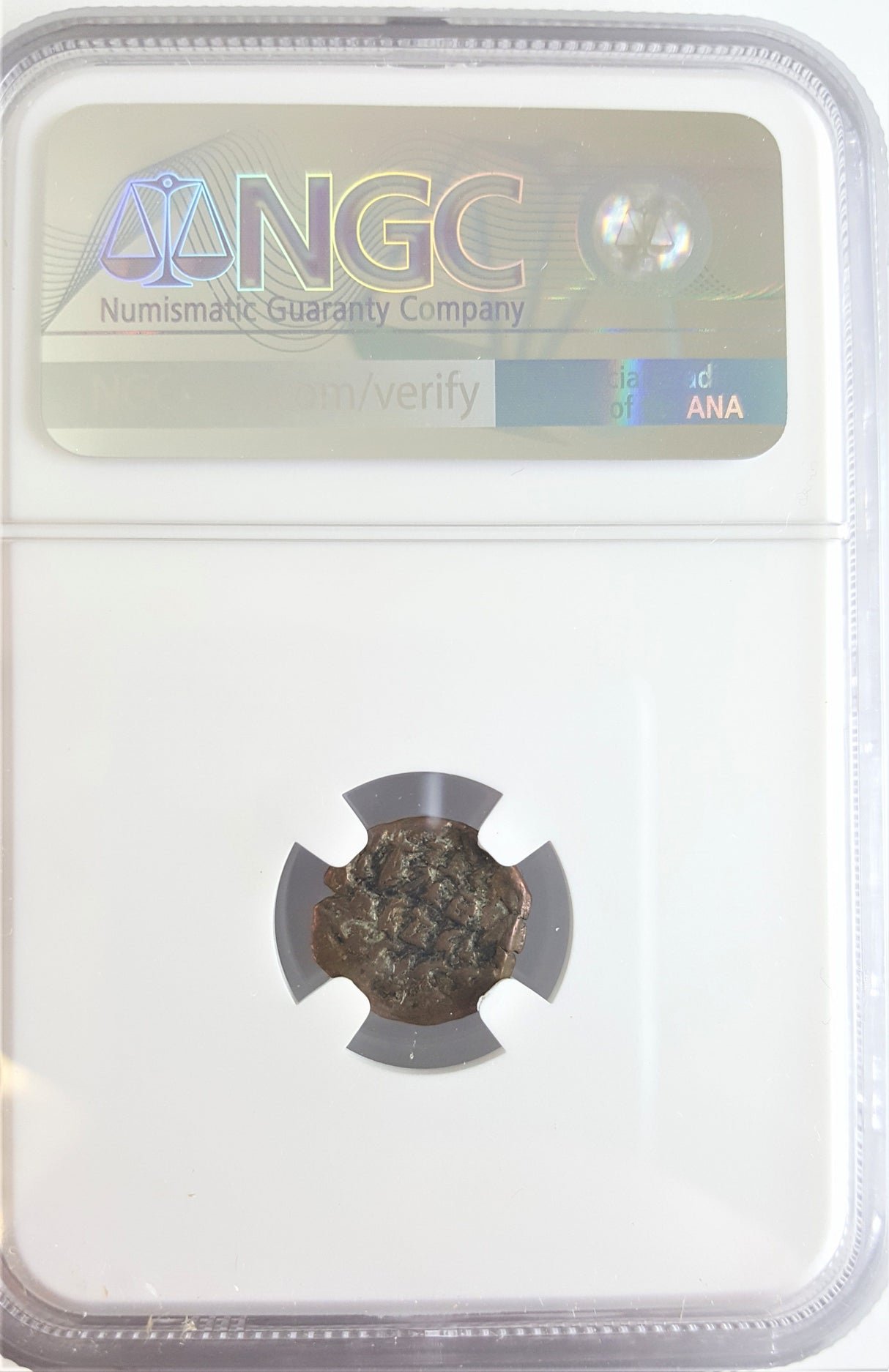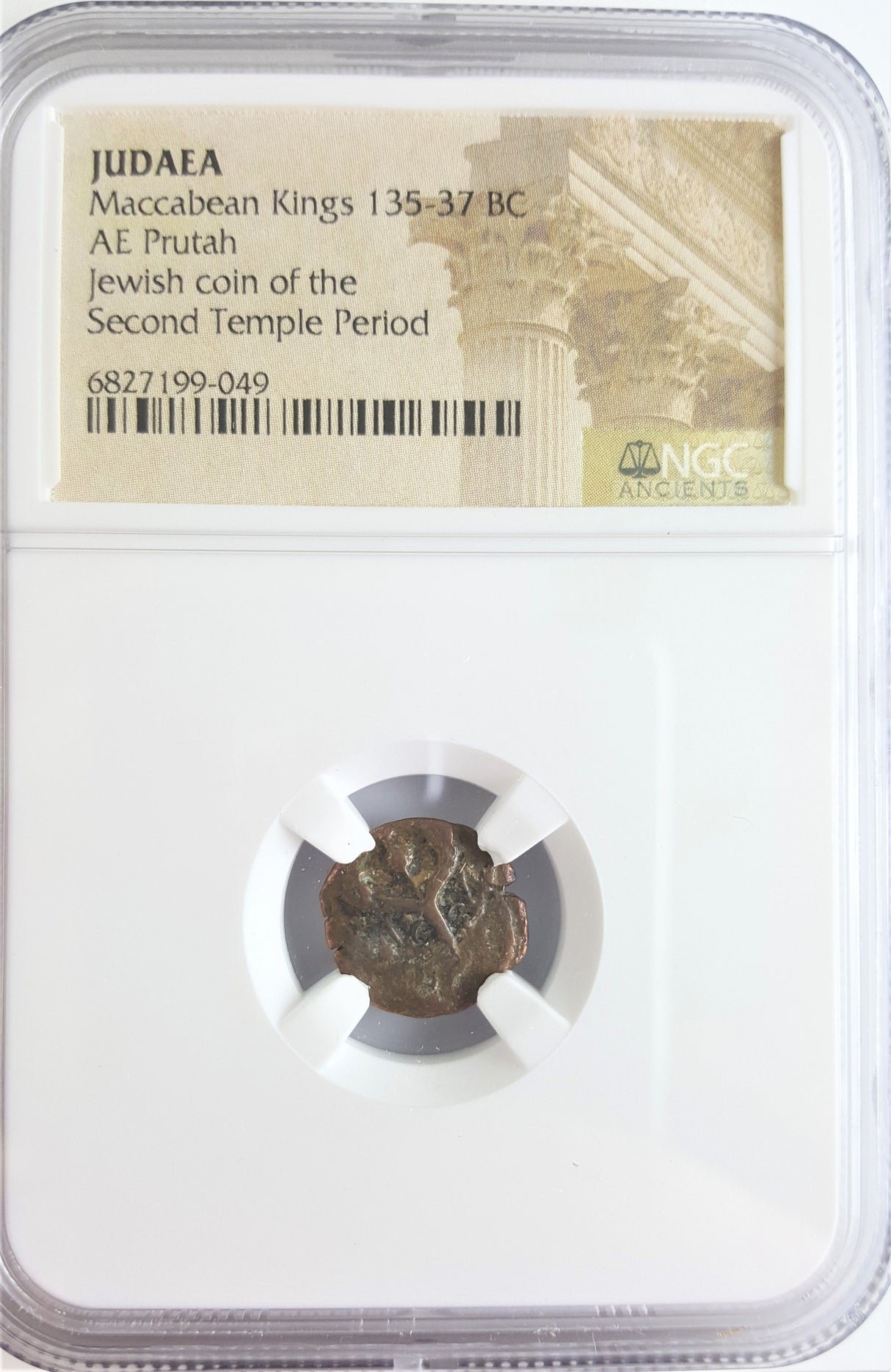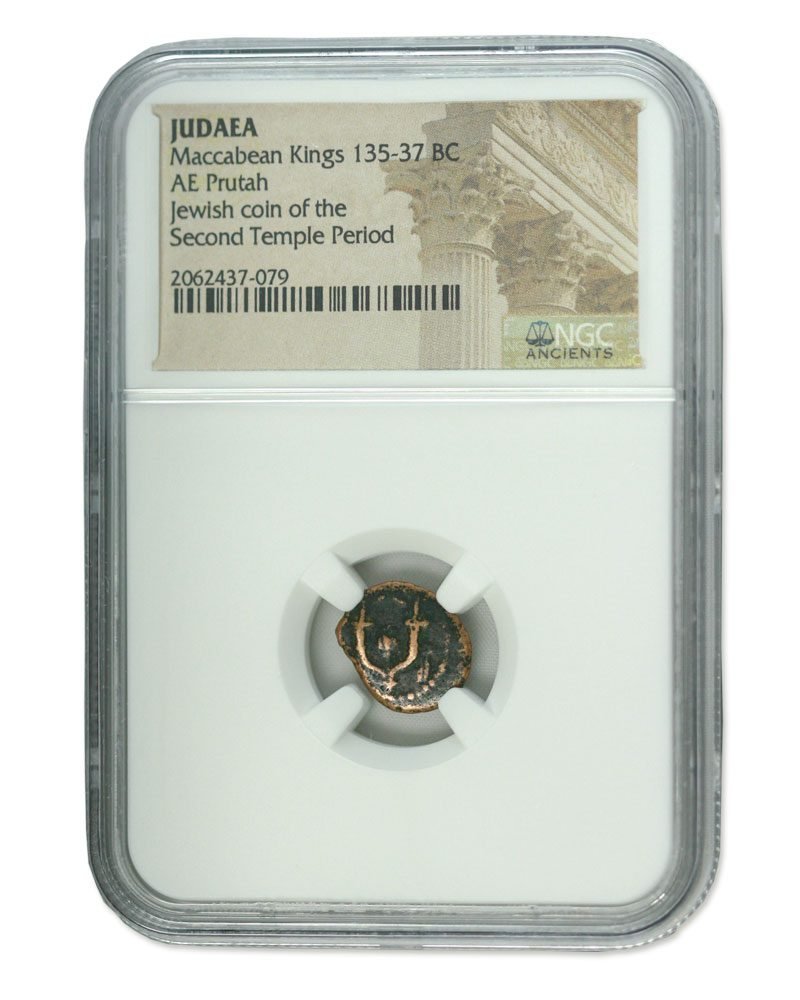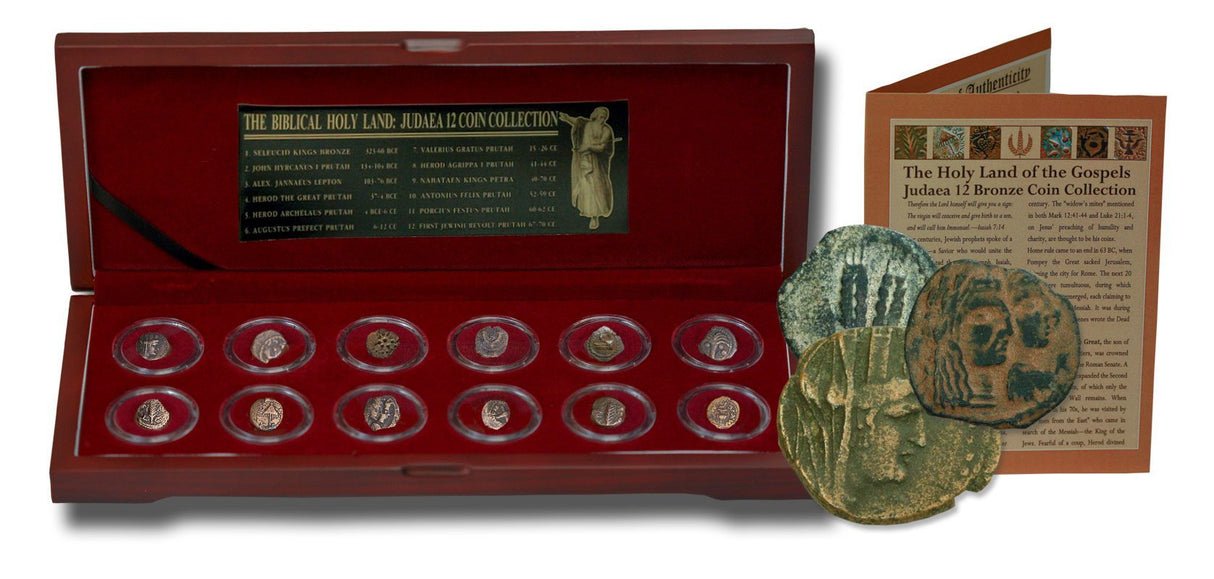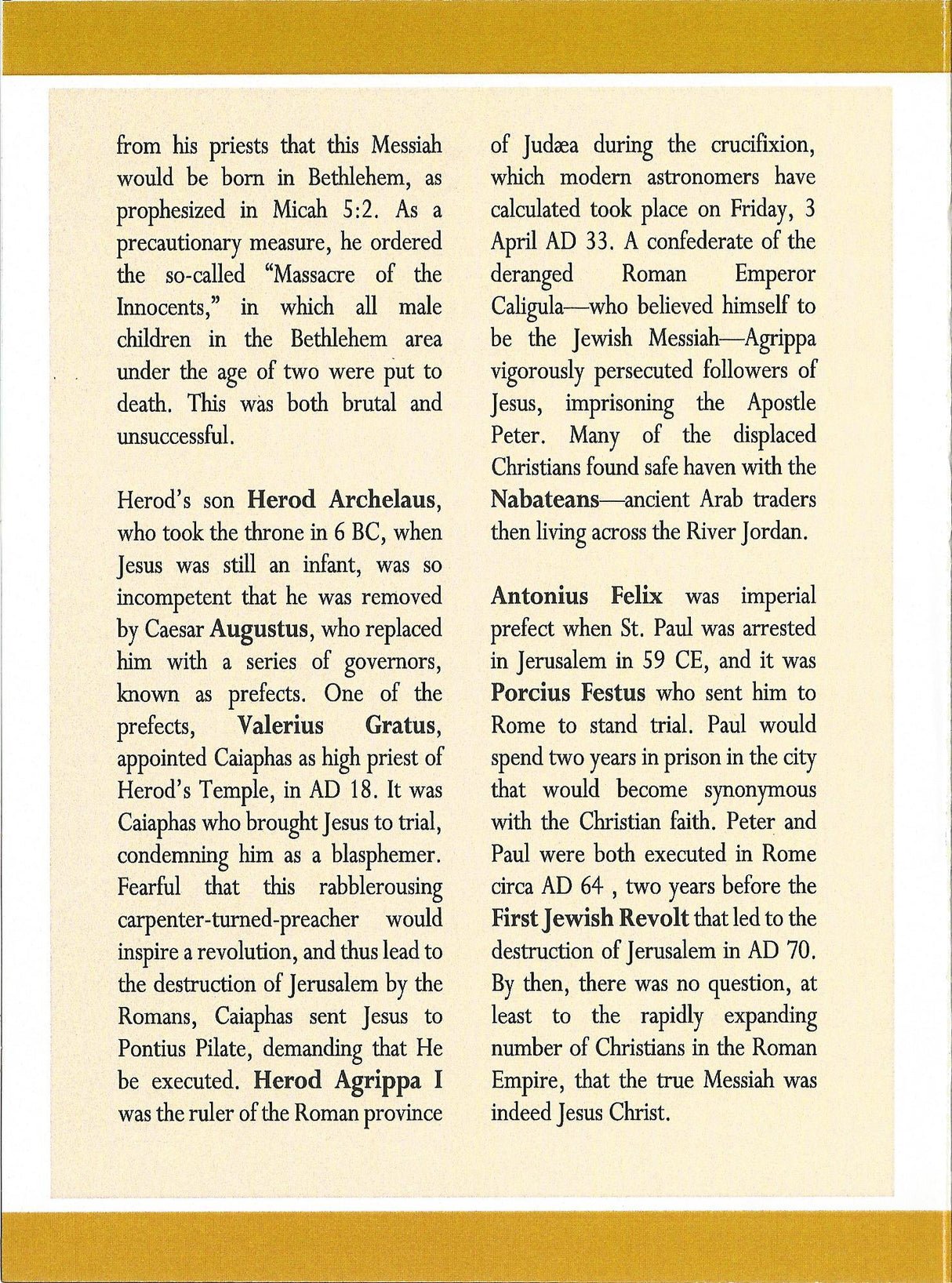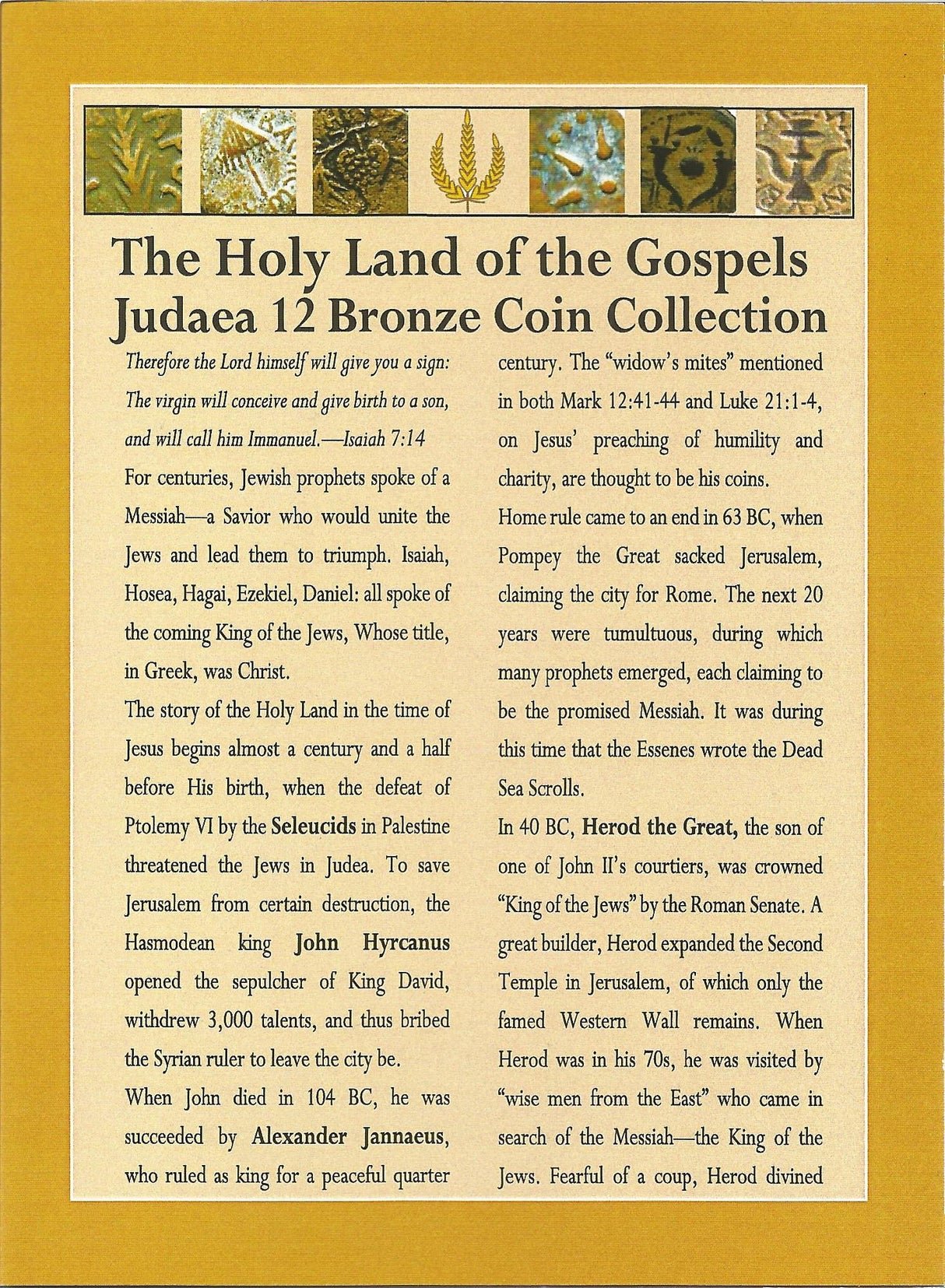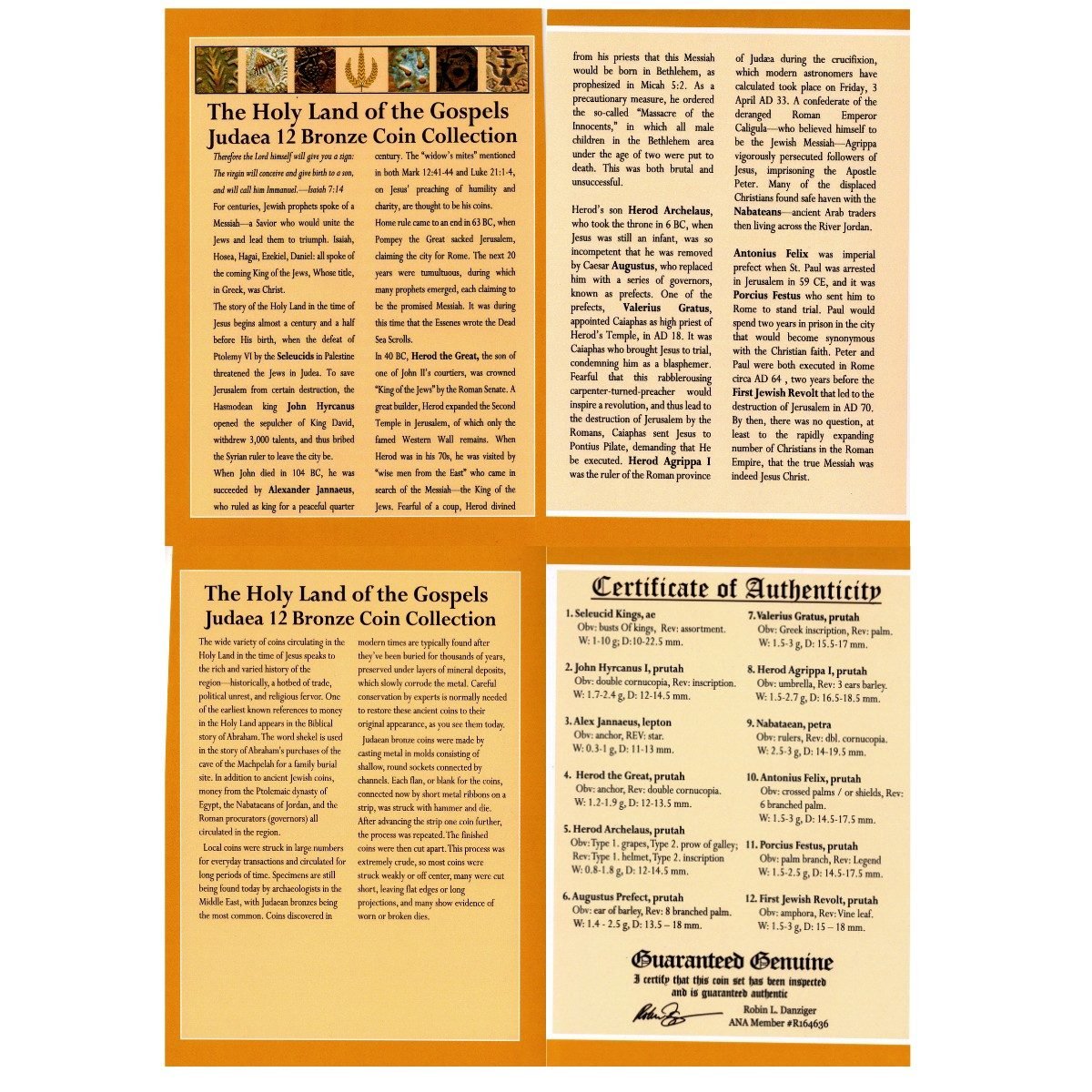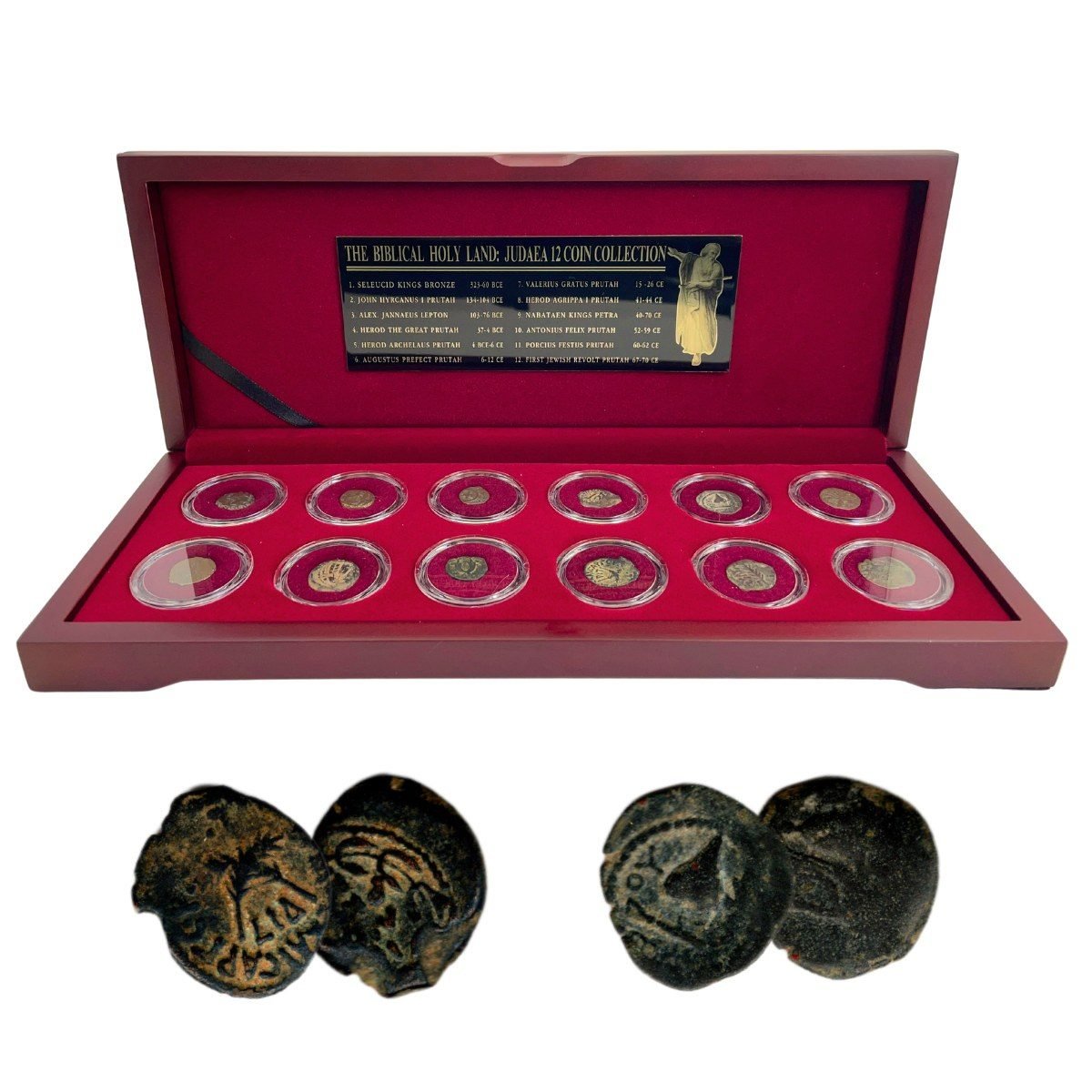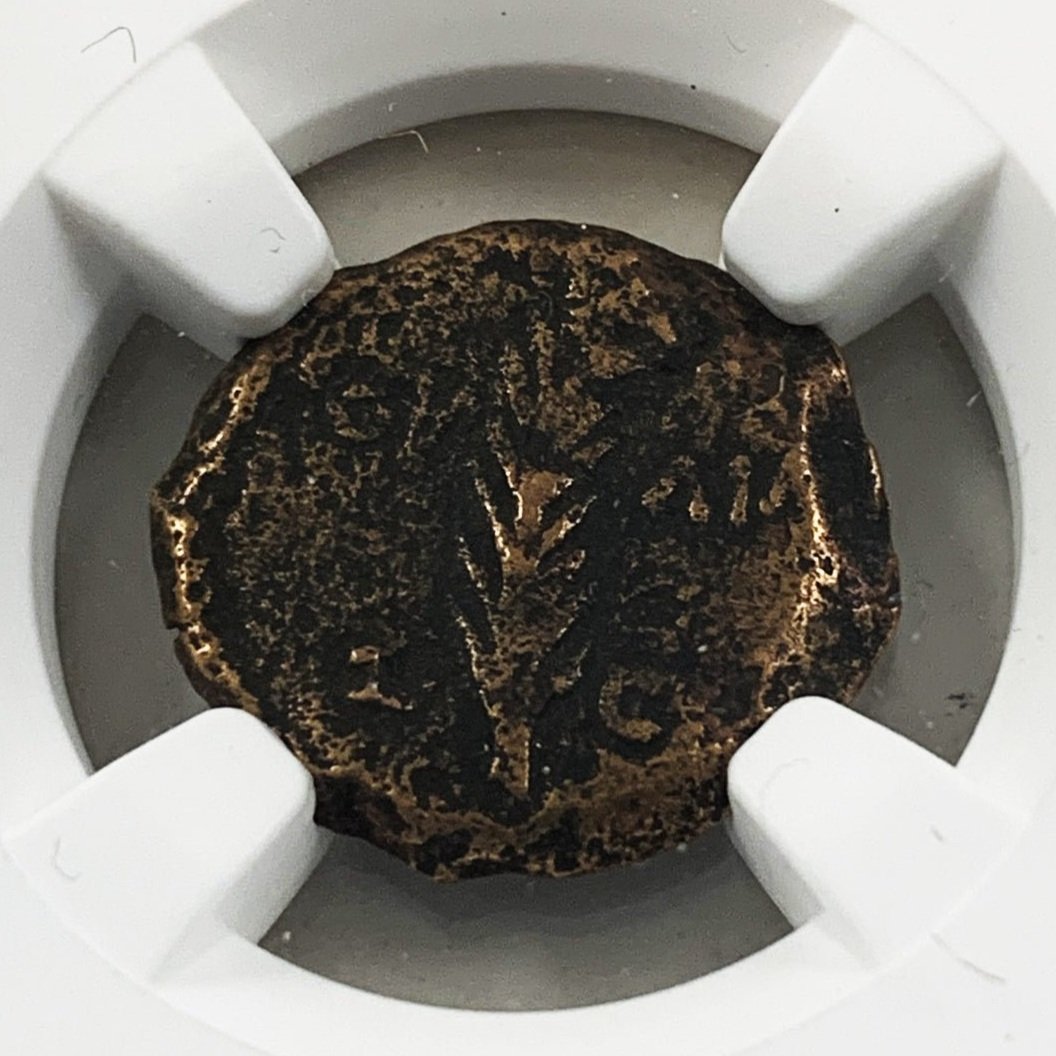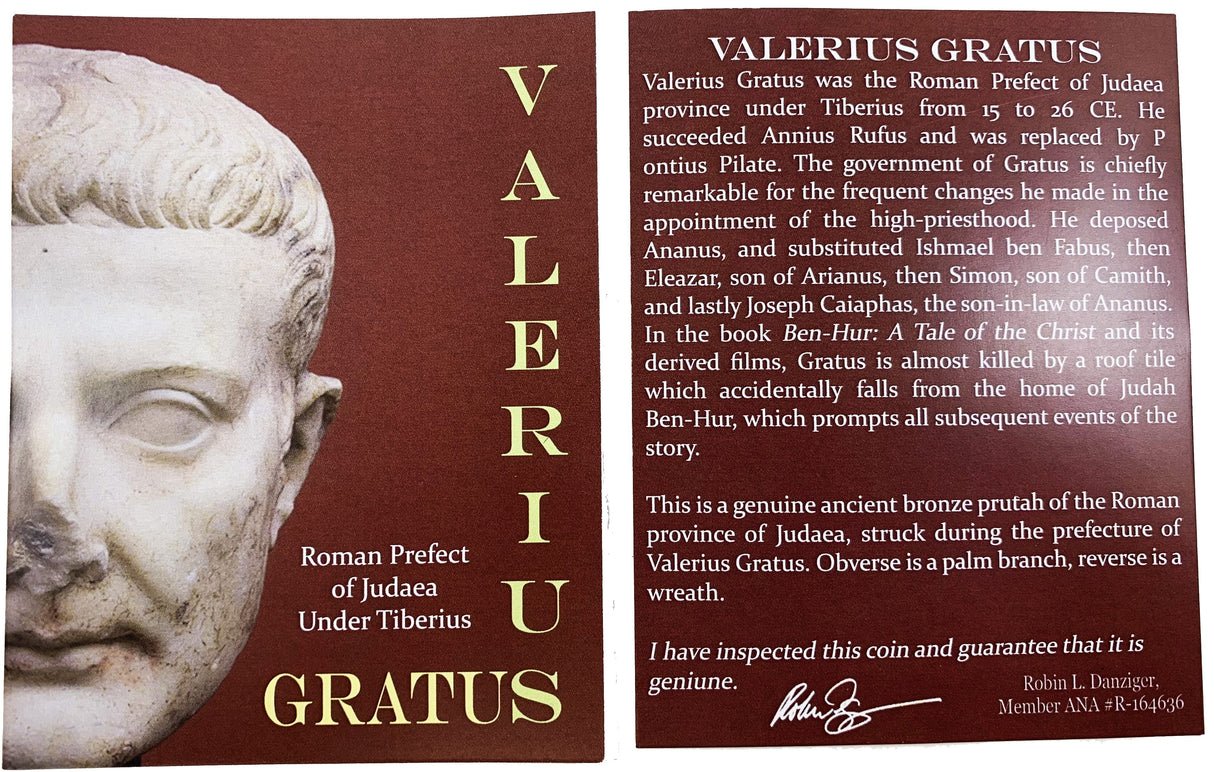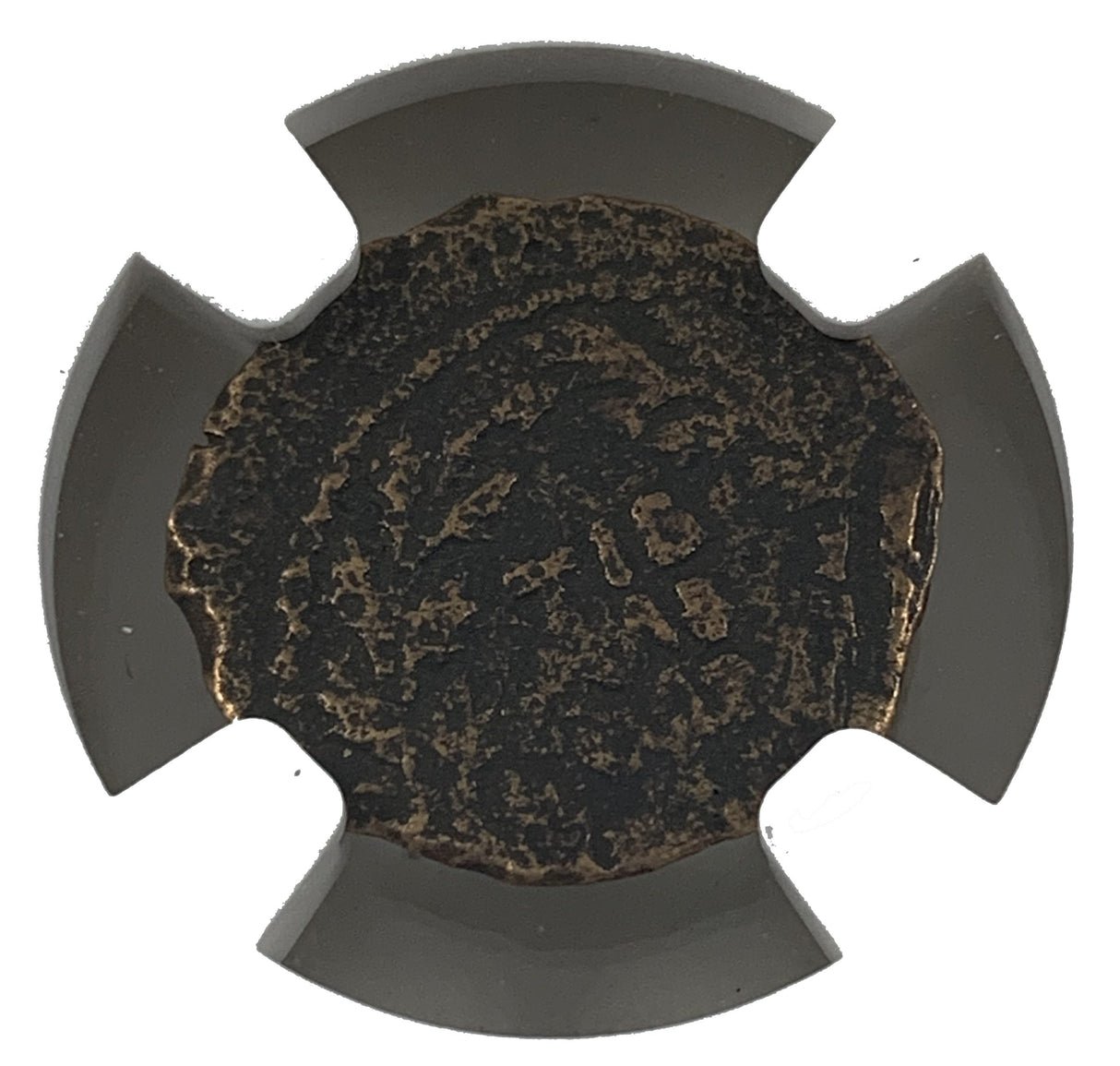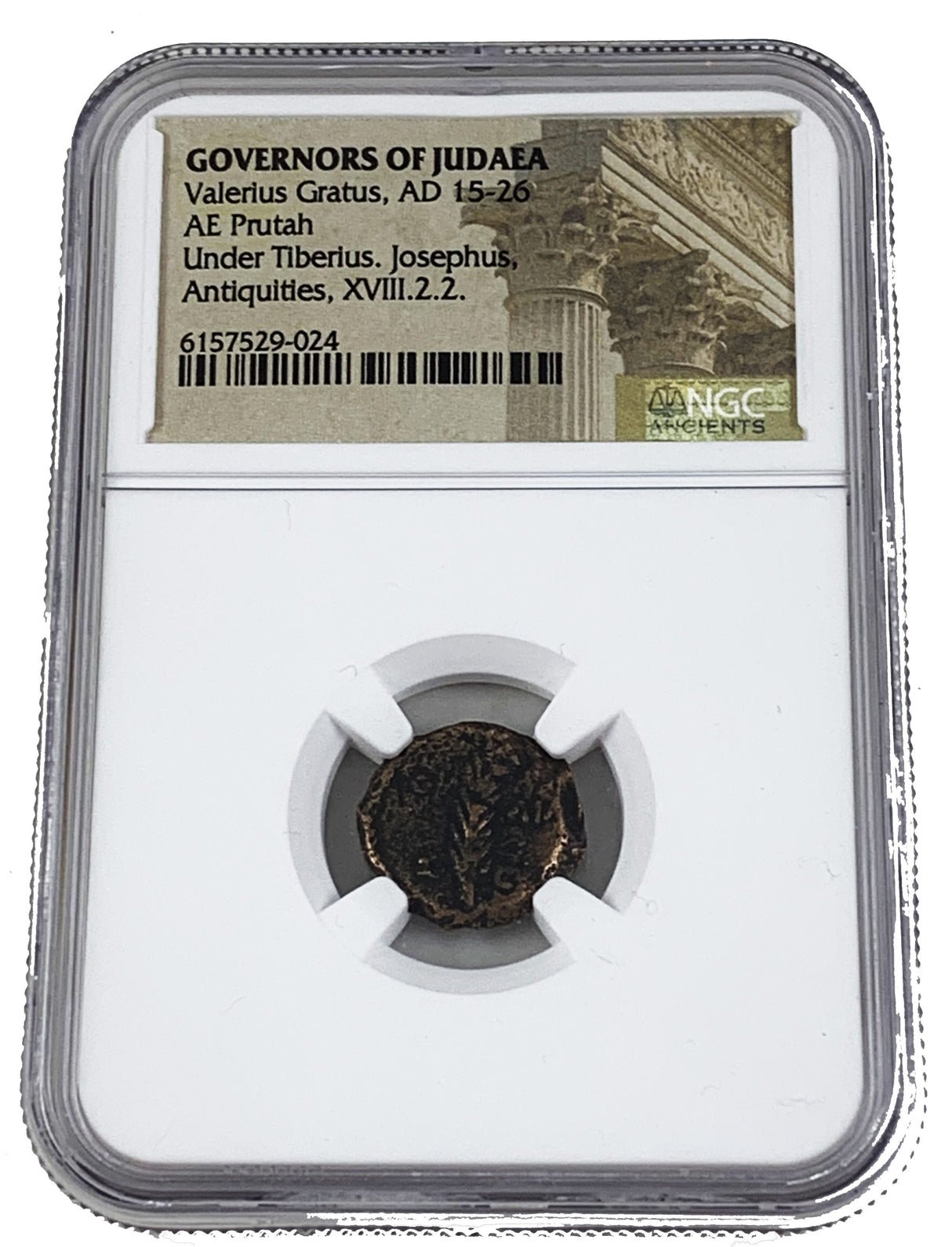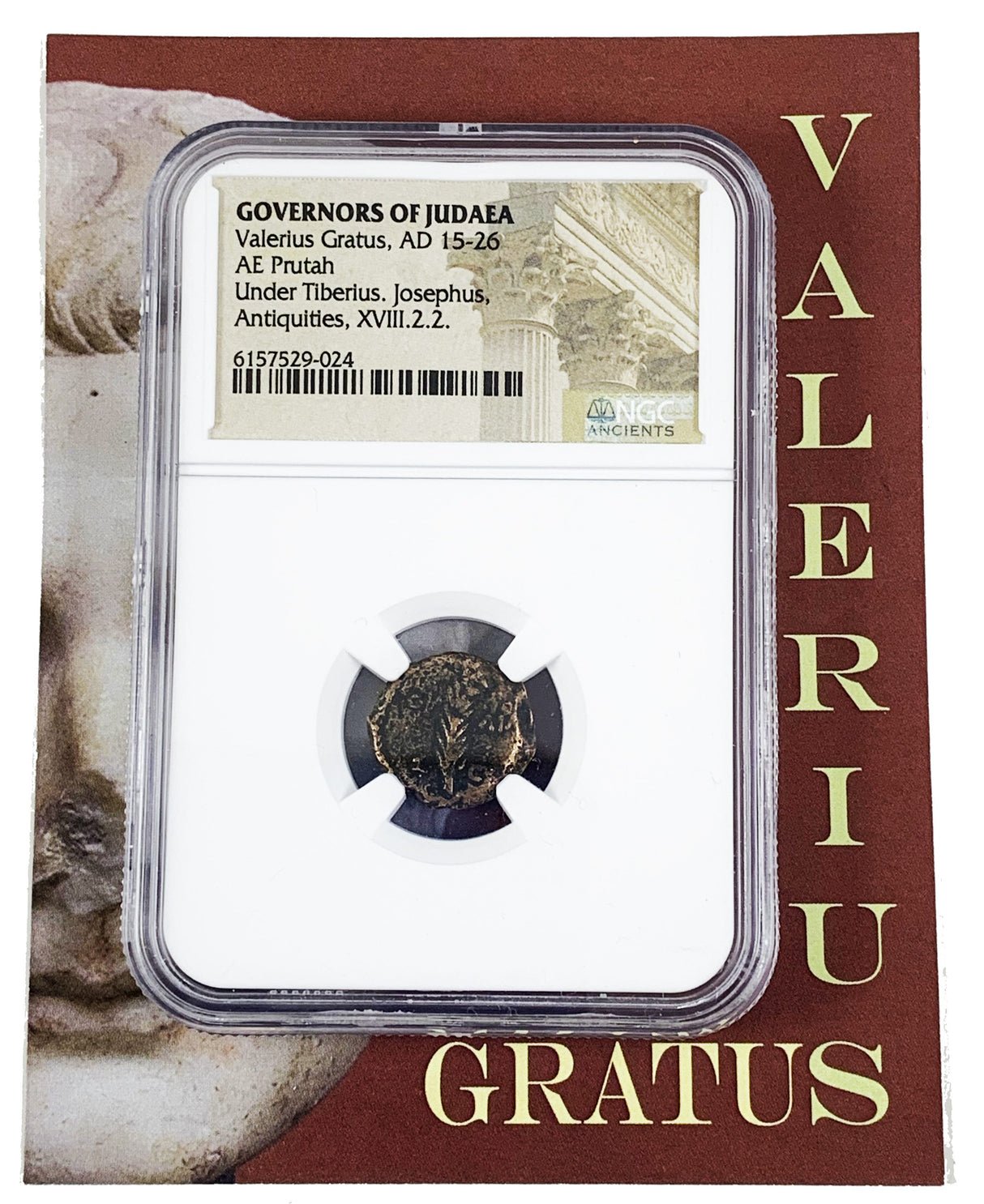 Image 1 of 2
Image 1 of 2

 Image 2 of 2
Image 2 of 2



Herod Dynasty: Three Judaean Bronze Coins of the Biblical Holy Land
I'll create detailed numismatic descriptions for the three Herodian dynasty coins following your requested format:
Herod Dynasty: Three Judaean Bronze Coins of the Biblical Holy Land
1. Herod I "The Great" Bronze Prutah (about 2050-2060 years ago)
This small bronze coin was minted during the reign of Herod I, appointed King of Judaea by the Romans after they conquered the region. Known as "The Great" for his massive building projects including the expansion of the Second Temple in Jerusalem, Herod ruled during the time of Jesus's birth.
Coin Description:
Front side: Double cornucopia (twin horns of plenty) symbolizing abundance and prosperity
Back side: Naval anchor, representing Herod's connection to maritime trade and Roman naval power
Technical Details:
Bronze composition
Denomination: Prutah (small bronze coin used in ancient Judaea)
Date: 37-4 BC
Historical Significance: This coin circulated throughout Judaea (modern Israel and Palestinian territories) during the reign of Herod the Great, who is infamous in biblical accounts for ordering the "Massacre of the Innocents." As a client king of Rome, Herod maintained Jewish religious sensibilities by avoiding human portraits on his coins while incorporating Greek and Roman design elements, reflecting the cultural tensions of the era.
2. Herod Archelaus Bronze Prutah (about 2020-2030 years ago)
This bronze coin was issued by Herod Archelaus, son of Herod the Great, who inherited a portion of his father's kingdom but ruled for only a decade before being deposed by Roman authorities due to complaints about his cruel governance.
Coin Description:
Front side: Cluster of grapes or galley prow (ship's front), reflecting the agricultural wealth or maritime connections of his territory
Back side: Wreath design, a symbol of victory and authority commonly used in Greco-Roman iconography
Technical Details:
Bronze composition
Denomination: Prutah
Date: 4 BC-AD 6
Historical Significance: This coin circulated briefly during the tumultuous period after Herod the Great's death when his kingdom was divided among his sons. Archelaus governed Judaea, Samaria, and Idumea with such harshness that his subjects petitioned Rome for his removal. His territory then became the Roman province of Judaea under direct Roman administration, setting the stage for the tensions that would eventually lead to the Jewish revolts.
3. Herod Agrippa I Bronze Prutah (about 1980 years ago)
This bronze coin was issued by Herod Agrippa I, grandson of Herod the Great, who was raised in Rome and became the last king to rule over a united Jewish kingdom before permanent Roman provincial administration.
Coin Description:
Front side: Ears of barley, symbolizing agricultural abundance and possibly alluding to the Jewish festival of Shavuot
Back side: Royal umbrella or canopy, an ancient symbol of royal authority in the Near East
Technical Details:
Bronze composition
Denomination: Prutah
Date: AD 41-44
Historical Significance: This coin circulated during the brief reign of Agrippa I, who appears in the New Testament as the king who executed James the Apostle and imprisoned Peter. Unlike his predecessors, Agrippa was popular with his Jewish subjects due to his observance of Jewish customs. His sudden death in AD 44 (described in Acts 12) ended the last period of semi-independent Jewish rule until modern times, after which Judaea reverted to direct Roman provincial control.
I'll create detailed numismatic descriptions for the three Herodian dynasty coins following your requested format:
Herod Dynasty: Three Judaean Bronze Coins of the Biblical Holy Land
1. Herod I "The Great" Bronze Prutah (about 2050-2060 years ago)
This small bronze coin was minted during the reign of Herod I, appointed King of Judaea by the Romans after they conquered the region. Known as "The Great" for his massive building projects including the expansion of the Second Temple in Jerusalem, Herod ruled during the time of Jesus's birth.
Coin Description:
Front side: Double cornucopia (twin horns of plenty) symbolizing abundance and prosperity
Back side: Naval anchor, representing Herod's connection to maritime trade and Roman naval power
Technical Details:
Bronze composition
Denomination: Prutah (small bronze coin used in ancient Judaea)
Date: 37-4 BC
Historical Significance: This coin circulated throughout Judaea (modern Israel and Palestinian territories) during the reign of Herod the Great, who is infamous in biblical accounts for ordering the "Massacre of the Innocents." As a client king of Rome, Herod maintained Jewish religious sensibilities by avoiding human portraits on his coins while incorporating Greek and Roman design elements, reflecting the cultural tensions of the era.
2. Herod Archelaus Bronze Prutah (about 2020-2030 years ago)
This bronze coin was issued by Herod Archelaus, son of Herod the Great, who inherited a portion of his father's kingdom but ruled for only a decade before being deposed by Roman authorities due to complaints about his cruel governance.
Coin Description:
Front side: Cluster of grapes or galley prow (ship's front), reflecting the agricultural wealth or maritime connections of his territory
Back side: Wreath design, a symbol of victory and authority commonly used in Greco-Roman iconography
Technical Details:
Bronze composition
Denomination: Prutah
Date: 4 BC-AD 6
Historical Significance: This coin circulated briefly during the tumultuous period after Herod the Great's death when his kingdom was divided among his sons. Archelaus governed Judaea, Samaria, and Idumea with such harshness that his subjects petitioned Rome for his removal. His territory then became the Roman province of Judaea under direct Roman administration, setting the stage for the tensions that would eventually lead to the Jewish revolts.
3. Herod Agrippa I Bronze Prutah (about 1980 years ago)
This bronze coin was issued by Herod Agrippa I, grandson of Herod the Great, who was raised in Rome and became the last king to rule over a united Jewish kingdom before permanent Roman provincial administration.
Coin Description:
Front side: Ears of barley, symbolizing agricultural abundance and possibly alluding to the Jewish festival of Shavuot
Back side: Royal umbrella or canopy, an ancient symbol of royal authority in the Near East
Technical Details:
Bronze composition
Denomination: Prutah
Date: AD 41-44
Historical Significance: This coin circulated during the brief reign of Agrippa I, who appears in the New Testament as the king who executed James the Apostle and imprisoned Peter. Unlike his predecessors, Agrippa was popular with his Jewish subjects due to his observance of Jewish customs. His sudden death in AD 44 (described in Acts 12) ended the last period of semi-independent Jewish rule until modern times, after which Judaea reverted to direct Roman provincial control.
I'll create detailed numismatic descriptions for the three Herodian dynasty coins following your requested format:
Herod Dynasty: Three Judaean Bronze Coins of the Biblical Holy Land
1. Herod I "The Great" Bronze Prutah (about 2050-2060 years ago)
This small bronze coin was minted during the reign of Herod I, appointed King of Judaea by the Romans after they conquered the region. Known as "The Great" for his massive building projects including the expansion of the Second Temple in Jerusalem, Herod ruled during the time of Jesus's birth.
Coin Description:
Front side: Double cornucopia (twin horns of plenty) symbolizing abundance and prosperity
Back side: Naval anchor, representing Herod's connection to maritime trade and Roman naval power
Technical Details:
Bronze composition
Denomination: Prutah (small bronze coin used in ancient Judaea)
Date: 37-4 BC
Historical Significance: This coin circulated throughout Judaea (modern Israel and Palestinian territories) during the reign of Herod the Great, who is infamous in biblical accounts for ordering the "Massacre of the Innocents." As a client king of Rome, Herod maintained Jewish religious sensibilities by avoiding human portraits on his coins while incorporating Greek and Roman design elements, reflecting the cultural tensions of the era.
2. Herod Archelaus Bronze Prutah (about 2020-2030 years ago)
This bronze coin was issued by Herod Archelaus, son of Herod the Great, who inherited a portion of his father's kingdom but ruled for only a decade before being deposed by Roman authorities due to complaints about his cruel governance.
Coin Description:
Front side: Cluster of grapes or galley prow (ship's front), reflecting the agricultural wealth or maritime connections of his territory
Back side: Wreath design, a symbol of victory and authority commonly used in Greco-Roman iconography
Technical Details:
Bronze composition
Denomination: Prutah
Date: 4 BC-AD 6
Historical Significance: This coin circulated briefly during the tumultuous period after Herod the Great's death when his kingdom was divided among his sons. Archelaus governed Judaea, Samaria, and Idumea with such harshness that his subjects petitioned Rome for his removal. His territory then became the Roman province of Judaea under direct Roman administration, setting the stage for the tensions that would eventually lead to the Jewish revolts.
3. Herod Agrippa I Bronze Prutah (about 1980 years ago)
This bronze coin was issued by Herod Agrippa I, grandson of Herod the Great, who was raised in Rome and became the last king to rule over a united Jewish kingdom before permanent Roman provincial administration.
Coin Description:
Front side: Ears of barley, symbolizing agricultural abundance and possibly alluding to the Jewish festival of Shavuot
Back side: Royal umbrella or canopy, an ancient symbol of royal authority in the Near East
Technical Details:
Bronze composition
Denomination: Prutah
Date: AD 41-44
Historical Significance: This coin circulated during the brief reign of Agrippa I, who appears in the New Testament as the king who executed James the Apostle and imprisoned Peter. Unlike his predecessors, Agrippa was popular with his Jewish subjects due to his observance of Jewish customs. His sudden death in AD 44 (described in Acts 12) ended the last period of semi-independent Jewish rule until modern times, after which Judaea reverted to direct Roman provincial control.




